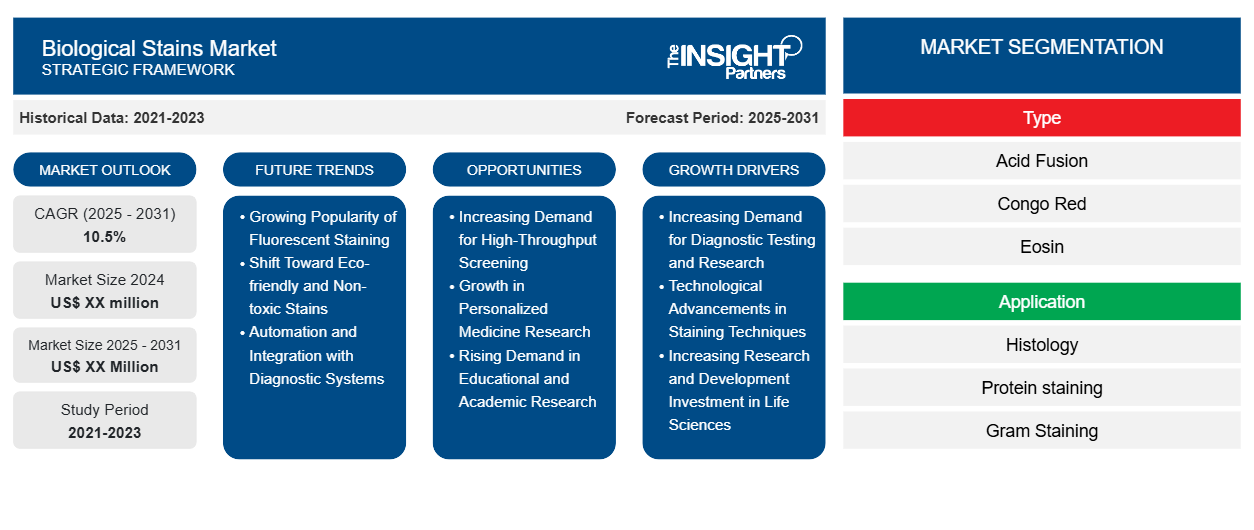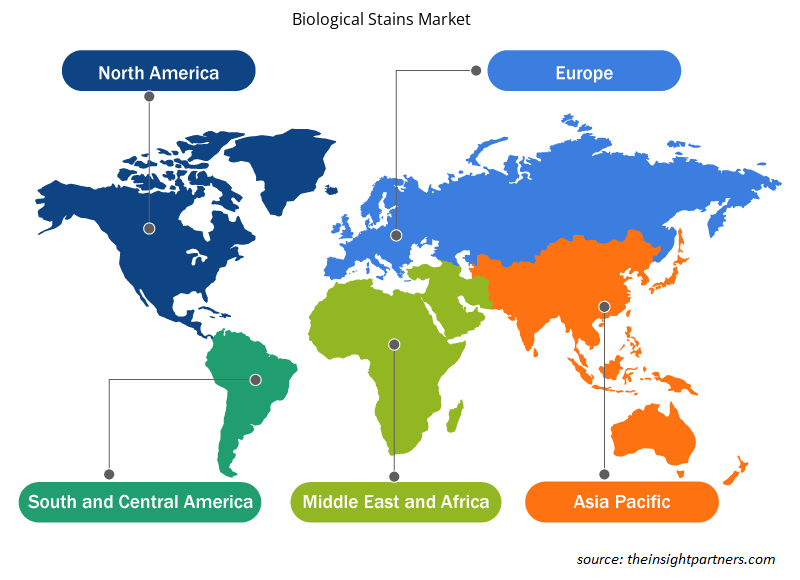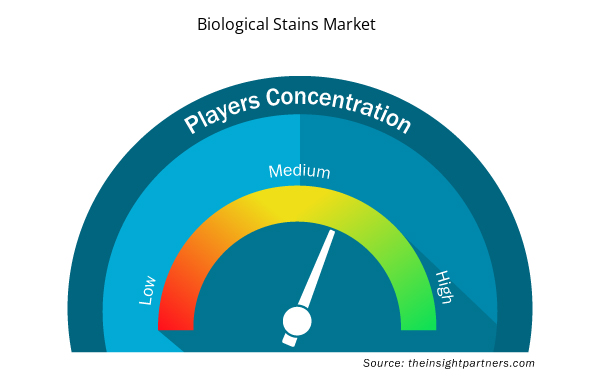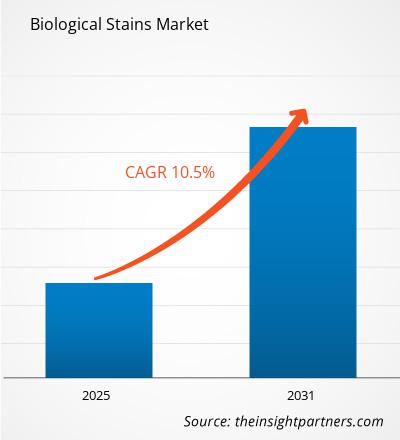The Biological Stains Market is expected to register a CAGR of 10.5% from 2025 to 2031, with a market size expanding from US$ XX million in 2024 to US$ XX Million by 2031.
The report is segmented by Type (Acid Fusion, Congo Red, Eosin, Others); Application (Histology, Protein staining, Gram Staining, Others), and End User (Diagnostics Laboratories, Others). The global analysis is broken down at the regional level and for major countries. The market evaluation is presented in US$ for the above segmental analysis.
Purpose of the Report
The report Biological Stains Market by The Insight Partners aims to describe the present landscape and future growth, top driving factors, challenges, and opportunities. This will provide insights to various business stakeholders, such as:
- Technology Providers/Manufacturers: To understand the evolving market dynamics and know the potential growth opportunities, enabling them to make informed strategic decisions.
- Investors: To conduct a comprehensive trend analysis regarding the market growth rate, market financial projections, and opportunities that exist across the value chain.
- Regulatory bodies: To regulate policies and police activities in the market with the aim of minimizing abuse, preserving investor trust and confidence, and upholding the integrity and stability of the market.
Biological Stains Market Segmentation
Type
- Acid Fusion
- Congo Red
- Eosin
Application
- Histology
- Protein staining
- Gram Staining
End User
- Diagnostics Laboratories
Customize This Report To Suit Your Requirement
You will get customization on any report - free of charge - including parts of this report, or country-level analysis, Excel Data pack, as well as avail great offers and discounts for start-ups & universities
Biological Stains Market: Strategic Insights

- Get Top Key Market Trends of this report.This FREE sample will include data analysis, ranging from market trends to estimates and forecasts.
Biological Stains Market Growth Drivers
- Increasing Demand for Diagnostic Testing and Research: The increasing demand for diagnostic testing and research is a key driver of the biological stains market. Biological stains are critical in various laboratory applications, particularly in histology, cytology, and microbiology. These stains are essential for visualizing cellular structures and identifying pathogens, making them indispensable in diagnostic testing. With the rising prevalence of diseases such as cancer, infectious diseases, and chronic conditions, there is an increased need for precise diagnostic tools, which in turn drives the demand for biological stains. Furthermore, the growing focus on medical research, particularly in fields like molecular biology, pathology, and genetics, is expanding the market for stains used in experimental and diagnostic procedures. The growing global demand for healthcare and research services, as well as the emphasis on early disease detection, is fueling the biological stains market. Market forecasts suggest that as healthcare systems continue to prioritize disease prevention and early diagnosis, the demand for biological stains will rise. This trend is supported by advancements in staining technologies, which improve the precision and reliability of diagnostic tests, leading to better patient outcomes. As the medical and research sectors continue to grow, the biological stains market will see increased demand for innovative and effective staining solutions.
- Technological Advancements in Staining Techniques: Technological advancements in staining techniques are another significant growth driver in the biological stains market. Innovations in staining protocols, such as the development of advanced dyes and reagents, have greatly improved the accuracy, speed, and ease of biological staining processes. For example, newer stains are being developed to target specific cellular components with high precision, enabling more detailed and informative visualizations. Additionally, the integration of staining techniques with modern imaging technologies, such as fluorescence microscopy and confocal microscopy, has opened new possibilities for biological research and diagnostics. These innovations have not only enhanced the capabilities of biological stains but also expanded their applications in fields like oncology, immunology, and microbiology. Market forecasts indicate that the ongoing development of cutting-edge staining techniques will continue to support the growth of the biological stains market. As researchers and healthcare professionals adopt more sophisticated staining methods, the demand for high-quality and specialized biological stains will increase, further driving market growth. The trend towards more efficient and precise diagnostic tools will continue to fuel the development of advanced staining products, ultimately benefiting both research and clinical settings.
- Increasing Research and Development Investment in Life Sciences: Another key growth driver for the biological stains market is the increasing investment in research and development (R&D) within the life sciences sector. The growing emphasis on scientific research, particularly in fields like genomics, proteomics, and drug discovery, is boosting the demand for biological stains. These stains play a pivotal role in various research applications, such as identifying proteins, nucleic acids, and other biological markers, which are critical in understanding diseases and developing treatments. As governments, private organizations, and academic institutions allocate more funding to life sciences research, there is a rising demand for high-quality biological stains. Moreover, the rapid advancements in biotechnology and pharmaceuticals have created new opportunities for biological stains in drug development and clinical trials. Market forecasts suggest that as the focus on scientific discovery continues to grow, the demand for biological stains will expand, particularly in emerging areas such as personalized medicine and biomarker research. The ongoing investment in the life sciences industry will likely stimulate innovations in biological staining products, thereby increasing their use across a wide range of applications.
Biological Stains Market Future Trends
- Growing Popularity of Fluorescent Staining: Fluorescent staining has become an increasingly popular trend in the biological stains market. This method, which uses fluorescent dyes to bind to specific cellular components, allows for highly sensitive detection and detailed visualization of biological samples. Fluorescent staining is widely used in molecular biology, cell biology, and diagnostic testing, particularly in applications like immunohistochemistry, flow cytometry, and fluorescence in situ hybridization (FISH). The development of more advanced fluorescent dyes, with better specificity and sensitivity, has driven the adoption of this technique in both research and clinical diagnostics. Market forecasts indicate that the use of fluorescent staining will continue to rise due to its ability to provide real-time, high-resolution imaging with minimal sample preparation. This trend is particularly strong in cancer research, where fluorescent staining is used to identify tumor cells and biomarkers. The ongoing advancements in fluorescent staining technology, such as the development of multiplexing techniques and brighter dyes, will likely further accelerate market growth.
- Shift Toward Eco-friendly and Non-toxic Stains: A notable trend in the biological stains market is the shift toward eco-friendly and non-toxic stains. As awareness of environmental and health concerns increases, researchers and healthcare providers are seeking alternatives to traditional chemical stains that may pose risks to both the environment and users. Eco-friendly stains are biodegradable and free from harmful chemicals, making them safer to handle and dispose of. This trend is driven by the increasing demand for sustainable laboratory practices and the growing focus on reducing the use of hazardous materials. Market forecasts suggest that the demand for non-toxic and environmentally friendly biological stains will continue to rise, particularly as regulatory bodies introduce stricter guidelines for laboratory chemicals. Manufacturers are responding to this demand by developing innovative, safe, and effective stains that meet the needs of modern research while minimizing their environmental footprint. This trend is expected to create new market opportunities for biodegradable and safer alternatives to conventional stains.
- Automation and Integration with Diagnostic Systems: The integration of biological stains with automated diagnostic systems is a growing trend in the market. Automation is transforming laboratory processes, making them more efficient, accurate, and cost-effective. Biological stains are increasingly being used in automated systems, such as digital pathology platforms, where they help to analyze large volumes of tissue samples quickly and accurately. Automation reduces human error and improves the reproducibility of staining results, which is essential for high-throughput clinical diagnostics. Market forecasts suggest that the rise of automation in laboratories and diagnostic settings will drive the adoption of biological stains that are compatible with automated systems. This trend is particularly relevant in areas such as oncology, where large numbers of tissue samples need to be processed and analyzed. The ability to seamlessly integrate stains with automated diagnostic platforms will increase the demand for staining solutions that are optimized for automation, further contributing to market growth.
Biological Stains Market Opportunities
- Increasing Demand for High-Throughput Screening: High-throughput screening (HTS) is a significant opportunity in the biological stains market. HTS is a critical technology used by pharmaceutical companies, biotechnology firms, and academic research institutions to test large numbers of biological compounds quickly. Biological stains are essential in HTS as they enable researchers to visualize cellular changes in response to various compounds. These stains are crucial for identifying drug candidates and assessing their effects on biological systems. The growing focus on accelerating drug discovery, particularly in areas like cancer research, personalized medicine, and genetic disorders, is expected to drive the demand for biological stains. HTS relies heavily on stains that are highly sensitive, reliable, and capable of providing accurate results across large datasets. With advancements in automation, HTS platforms are becoming more efficient, increasing the demand for compatible biological stains. Manufacturers that can develop innovative staining solutions that meet the needs of HTS, such as stains compatible with automation and capable of multiplexing, will benefit from this growing opportunity. As pharmaceutical companies and research labs continue to adopt HTS methods to speed up drug development, the biological stains market will experience significant growth, driven by the increasing demand for high-performance staining solutions to support these advanced technologies.
- Growth in Personalized Medicine Research: Personalized medicine represents a major growth opportunity for the biological stains market. This approach tailors medical treatments to individuals based on their genetic makeup, lifestyle, and specific disease characteristics. Biological stains play a pivotal role in personalized medicine by identifying biomarkers, cellular structures, and genetic variations that inform treatment decisions. In oncology, for instance, stains are used to differentiate between various types of tumors, enabling healthcare providers to select the most appropriate treatment for each patient. As the demand for personalized medicine continues to rise, so will the need for advanced biological stains that can identify disease markers with high precision. The growing adoption of precision therapies, particularly in areas like cancer, genetic disorders, and cardiovascular diseases, drives the need for highly specific staining techniques. Market forecasts suggest that the expansion of personalized medicine will create a growing demand for biological stains that support molecular profiling, genomic research, and biomarker identification. By developing staining solutions tailored to the requirements of personalized medicine, manufacturers can tap into a rapidly growing segment of the healthcare and life sciences industries. This shift toward precision medicine presents a lucrative opportunity for biological stains to support the advancement of tailored therapies and improve patient outcomes.
- Rising Demand in Educational and Academic Research: The educational and academic research sector represents another important growth opportunity for the biological stains market. Universities, research institutions, and educational laboratories require high-quality biological stains to conduct experiments in fields such as molecular biology, microbiology, and pharmacology. As global research funding increases and the number of academic studies expands, the demand for reliable and effective biological stains to support educational and research initiatives is growing. Stains are essential tools for both teaching and experimental purposes, as they help students and researchers analyze cellular structures, understand disease mechanisms, and develop new therapies. In particular, emerging research areas such as stem cell biology, gene therapy, and regenerative medicine require specialized staining techniques to visualize cellular activities at a molecular level. The increasing focus on advancing scientific knowledge and fostering innovation in life sciences is expected to drive demand for biological stains in academic settings. Manufacturers can capitalize on this opportunity by offering cost-effective, high-quality stains that cater to the educational and research markets. As educational institutions and research labs expand globally, particularly in developing regions, the biological stains market will experience increased demand and growth in this sector.
Biological Stains Market Regional Insights
The regional trends and factors influencing the Biological Stains Market throughout the forecast period have been thoroughly explained by the analysts at Insight Partners. This section also discusses Biological Stains Market segments and geography across North America, Europe, Asia Pacific, Middle East and Africa, and South and Central America.

- Get the Regional Specific Data for Biological Stains Market
Biological Stains Market Report Scope
| Report Attribute | Details |
|---|---|
| Market size in 2024 | US$ XX million |
| Market Size by 2031 | US$ XX Million |
| Global CAGR (2025 - 2031) | 10.5% |
| Historical Data | 2021-2023 |
| Forecast period | 2025-2031 |
| Segments Covered |
By Type
|
| Regions and Countries Covered | North America
|
| Market leaders and key company profiles |
Biological Stains Market Players Density: Understanding Its Impact on Business Dynamics
The Biological Stains Market market is growing rapidly, driven by increasing end-user demand due to factors such as evolving consumer preferences, technological advancements, and greater awareness of the product's benefits. As demand rises, businesses are expanding their offerings, innovating to meet consumer needs, and capitalizing on emerging trends, which further fuels market growth.
Market players density refers to the distribution of firms or companies operating within a particular market or industry. It indicates how many competitors (market players) are present in a given market space relative to its size or total market value.
Major Companies operating in the Biological Stains Market are:
- Thermo Fisher Scientific Inc.
- Avantor, Inc
- BD.
- Beckman Coulter, Inc.
- Merck KGaA
- F. Hoffmann-La Roche Ltd
Disclaimer: The companies listed above are not ranked in any particular order.

- Get the Biological Stains Market top key players overview
Key Selling Points
- Comprehensive Coverage: The report comprehensively covers the analysis of products, services, types, and end users of the Biological Stains Market, providing a holistic landscape.
- Expert Analysis: The report is compiled based on the in-depth understanding of industry experts and analysts.
- Up-to-date Information: The report assures business relevance due to its coverage of recent information and data trends.
- Customization Options: This report can be customized to cater to specific client requirements and suit the business strategies aptly.
The research report on the Biological Stains Market can, therefore, help spearhead the trail of decoding and understanding the industry scenario and growth prospects. Although there can be a few valid concerns, the overall benefits of this report tend to outweigh the disadvantages.
- Historical Analysis (2 Years), Base Year, Forecast (7 Years) with CAGR
- PEST and SWOT Analysis
- Market Size Value / Volume - Global, Regional, Country
- Industry and Competitive Landscape
- Excel Dataset



Report Coverage
Revenue forecast, Company Analysis, Industry landscape, Growth factors, and Trends

Segment Covered
This text is related
to segments covered.

Regional Scope
North America, Europe, Asia Pacific, Middle East & Africa, South & Central America

Country Scope
This text is related
to country scope.
Frequently Asked Questions
The Biological Stains Market is estimated to witness a CAGR of 10.5% from 2025 to 2031.
The major factors driving the Biological Stains Market are Increasing Demand for Diagnostic Testing and Research, Technological Advancements in Staining Techniques, Increasing Research and Development Investment in Life Sciences.
Future trends in the Biological Stains Market are Growing Popularity of Fluorescent Staining, Shift Toward Eco-friendly and Non-toxic Stains, and Automation and Integration with Diagnostic Systems.
Some of the players operating in the market are Thermo Fisher Scientific Inc., Avantor, Inc., BD., Beckman Coulter, Inc., Merck KGaA, F. Hoffmann-La Roche Ltd, Bio-Rad Laboratories, Inc., Water Corporation, bioMérieux SA., and PRA Health Sciences.
The report can be delivered in PDF/PPT format; we can also share an excel datasheet based on the request.
Some customization options available based on the request are an additional 3–5 company profiles and a country-specific analysis of 3–5 countries of your choice. Customizations are to be requested/discussed before making final order confirmation# as our team would review the same and check the feasibility.
Trends and growth analysis reports related to Life Sciences : READ MORE..
The List of Companies
1. Thermo Fisher Scientific Inc.
2. Avantor
3. Becton
4. Beckman Coulter
5. Merck KGaA
6. Hoffmann-La Roche Ltd
7. Bio-Rad Laboratories
8. Water Corporation
9. bioMerieux SA

 Get Free Sample For
Get Free Sample For